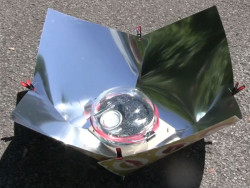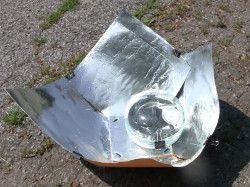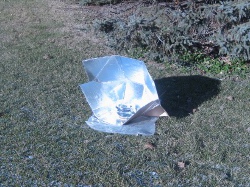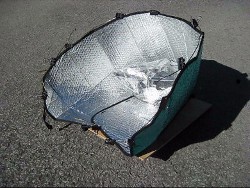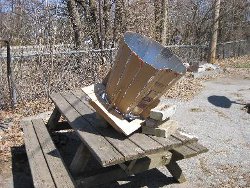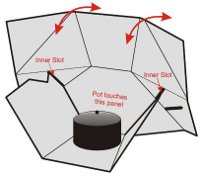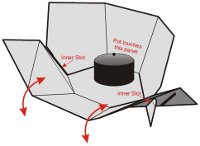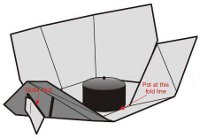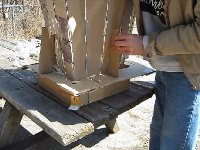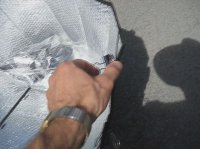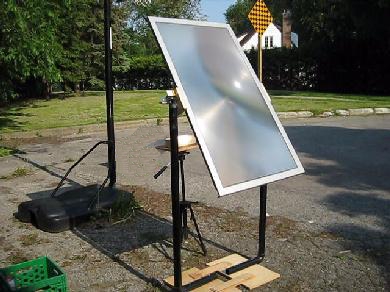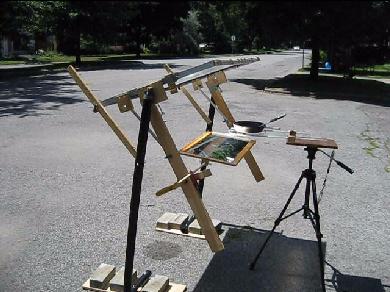Comparison of the solar cookers I've used so far. The following table contains a summary but details are given below.
| Cooker | Type | Performance | Sun angles | Types of vessels | Portability | Ease of setup | Frequency of adjustment |
|---|---|---|---|---|---|---|---|
| Copenhagen - commercially made | Slow | Excellent | All | Vessels larger than a jar | Excellent | Easy/1 minute | Infrequent/every 30 minutes to 1 hour |
| Copenhagen - homemade | Slow | Good | All | Vessels larger than a jar | Excellent | Easy/1 minute | Infrequent/every 30 minutes to 1 hour |
| Modified CooKit | Slow | Good | All | Vessels larger than a jar | Excellent | Easy/15 seconds | Infrequent/every 30 minutes to 1 hour |
| Car sunshade | Slow | Good | Low | Vessels larger than a jar | Excellent | Medium/1 minute | Infrequent/every 30 minutes to 1 hour |
| Cone solar cooker | Slow | Good | All | Small/jars | Good | Easy/45 seconds | Frequent/every 20 minutes |
| Fresnel lens | Fast | Excellent | All | All | Poor | Difficult 2 minutes without mirror, 5 minutes with mirror |
Frequent/every 5 minutes |
In the the first section below I first compare slow cooker types of solar cookers and then in the section that follows I compare fast cookers.
Slow cookers
Slow cookers are ones that heat up the food slowly and reach temperatures from 212F (100C) to around 400F (200C), depending on the cooker. The food is cooked slowly over a medium to long period of time, like cooking in an electric oven indoors. This is in contrast to a fast cooker (see below) which is like a stovetop heating element on high.
|
|
|
|
|
Performance
The cone solar cooker is the only one I've used all year round, including the hottest summer days. Most performed equally well during fall, winter and spring, except that the commercially made Copenhagen performed a little better due to it's better reflecting surfaces. The cone has a smaller sun capture area but is more optimized than the Modified CookIt or car sunshade.
Sun angles/when they can be used
The sun angle is the angle made by the sun when measured from the ground. It's sometimes referred to as the sun's altitude. In the middle of the day the sun is higher in the sky and so has a larger sun angle. The sun has a low sun angle early in the day when the sun is rising and later in the day when the sun is going down. Also, in northern latitudes (or southern latitudes if you're in the southern hemisphere), the sun is low in the sky during the whole day for most or all of the winter. Here in Ottawa, Ontario, Canada, which is at latitude 45 degrees north, the sun is at a low sun angle all day during the winter.
|
The Copenhagen, cone and Modified CooKit are good for any sun angle, whereas the car sunshade is usually good only for low sun angles, meaning typically early or late in the day.
That's the difference between a "Modified" CooKit and a regular CooKit. A regular CooKit is good only for low sun angles. The Modified CooKit can be flipped around and has different panels that the cooking vessel should be placed on depending on the sun angle.
|
Some people manage to use the car sunshade at higher angles by putting it in a container like a garbage can so that it can be pivoted to face upward more. I've never gotten this to work well; perhaps my sunshade is too flimsy. I'm sure I could do it if I made some sort of structure but that defeats the portability that I like it for.
Types of cooking vessels supported
The cone is limited to small vessels like jars simply because the cooking table within is not strong enough to hold larger ones. It's also limited in inner area.
I find the opposite is true for the car sunshade and Modified CooKit. They don't work as well for smaller cooking vessels the size of a jar because the sunlight isn't focused well enough and so much of it misses the jar. A larger cooking vessel works because it captures more sunlight. The Copenhagen solar cookers, the car sunshade and the Modified CooKit can handle medium to large cooking vessels.
Portability
I've carried a Copenhagen solar cooker, the car sunshade and the Modified CooKit all at the same time in a medium sized backpack - so they're very portable. The cone solar cooker is less portable though I could strap it to the rack on the back of my bike. None of them weigh enough to matter.
Ease of setup/take down
None of them take long to set up or take down. The Modified CooKit takes about 15 seconds to set up. The cone solar cooker takes about 45 seconds. The Copernhagen solar cookers take about a minute because their reflective panels have to be laced together and then shaped for the sun's position. The car sunshade also takes about a minute because I try to optimize its shape using clothes hanger wire and clips (see the photo on the right below.)
|
|
Take down for all of them is fast enough that your food won't get cool in the meantime.
Freqency of adjustment
I adjust the Copenhagen solar cookers, the car sunshade and the Modified CooKit only every half hour to 45 minutes and even every hour is reported to be okay. The cone solar cooker needs to be adjusted every 20 minutes or so.
The reason the car sunshade and the Modified CooKit don't need frequent adjustment is because they're not highly optimized to reflect all the sunlight on the cooking vessel at the same time. Instead some sunlight misses. But, as the sun moves, the sunlight that previously missed now hits. Having a large reflector area means that at all times at least an adequate amount of sunlight is on the vessel.
The reason the cone solar cooker needs more frequent adjustment is because it is highly optimized. So either all of the sunlight is reflected to the cooking vessel or not enough.
Fast cookers
Fast cookers are ones where the cooking pot receives a very large amount of concentrated sunlight, producing a lot of heat. They're like using a normal stovetop heating element set to high.
The only fast cooker I've worked with so far is my 4 foot by 2 foot fresnel lens. 4'x2' is big and is a lot of sunlight to focus on a cooking vessel. I can use it without a mirror, in which case the sunlight is directed down onto the cooking vessel, or with a mirror, in which case the sunlight is directed up to the bottom of the cooking vessel.
|
|
- Performance - Excellent. I've cooked meat, fried eggs and boiled water all in around the same time as you would on an electric stovetop.
- Sun angles/when they can be used - All sun angles are supported. I designed it for when the angle of the sun as measure from horizontal is from 18 degrees to 68 degrees, which is fine for my latitude of 45 degees north.
- Types of cooking vessels supported - All sizes of cooking vessels work.
- Portability - It is not very portable. The 4'x2' lens can't be folded up to be smaller. There are also the support structure and weights to keep it from falling.
- Ease of setup/take down - Without the mirror it takes around 2 minutes to set up and take down. With the mirror is takes around 5 minutes. If I take it down and then eat, my food will have cooled.
- Freqency of adjustment - It needs frequent adjustment, every 5 minutes or so, since it is highly optimized. Either all the sunlight is on the cooking vessel or not enough.

